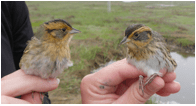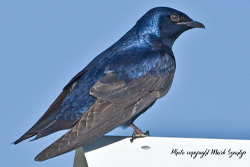Home → Fish & Wildlife → Wildlife → Species Information → Birds → Songbirds
Songbirds
Songbirds by the dozens are found in Maine. These small birds frequent our forests, fields and backyards, come to our feeders in the winter, and herald the arrival of spring with their melodic song and colorful plumage. Songbirds represent a diverse array of species (well over 100 species actually) and include such different species as the American Crow, Downy Woodpecker, Eastern Phoebe, and Ruby-throated Hummingbird. Most migrate south to warmer places for the winter while others prefer to stay with us. The few that remain manage to find food and shelter to sustain their tiny bodies for the long winter. Each is uniquely adapted to exploit its niche with great efficiency.
| Species | 1966-2010 | 2000-2010 | Interpretation |
|---|---|---|---|
| Barn Swallow | -5.9% | -6.0% | Declining |
| Bobolink | -2.8% | -3.3% | Declining |
| Ovenbird | + 0.2% | + 0.4% | Stable |
| Northern Cardinal | +11.5% | +7.1% | Increasing |
| Tufted Titmouse | +17.7% | +12.6% | Increasing |
Only the Crow is hunted, whereas all others are afforded complete protection under the Migratory Bird Treaty Act. Despite such protections, populations of many species in Maine (and regionally) still face threats. There are only a few species that are listed as Endangered or Threatened under the Maine Endangered Species Act. These species are limited to just a few locations and consequently their presence in Maine is vulnerable. The Grasshopper Sparrow and the American Pipit occur on protected lands, but species like the Sedge Wren occurs more sporadically. Other species that are more widespread and abundant may still be in trouble. The North American Breeding Bird Survey tracks population of birds (mostly songbirds) using roadside point counts of singing birds. This survey shows that many species, though not all, are in decline across Maine, and for some, across the entire northeast. The above table provides a sample of species whose populations are adequately tracked by the North American Breeding Bird Survey. Department staff participate in several of these early morning surveys each year. Results of these surveys contribute decisions regarding Endangered/Threatened listing, or more simply, whether species should be considered “Special Concern” warranting a close watch over time.

Nelson's Sparrow (left) and
Saltmarsh Sparrow (right)
have been the focus of Dept.
research in recent years.
(Photo Credit: K. Ruskin)
Two species, considered “Special Concern” in Maine are the Saltmarsh Sparrow and Rusty Blackbird. In recent years, focused surveys for these species have been conducted to attain more information on how many individuals of these species occur here and where these populations are located. Also, detailed studies of local populations have been conducted using outside funds to better understand why their populations are so sparse and to evaluate how vulnerable they are. These research projects have engaged numerous partners, both in state and out, and brought a regional focus to Maine’s efforts to conserve these songbird species.
Flying Purple Insect Eaters: Purple Martin and Other Aerial Insectivores in Maine

Photo byMark Szantyr.
This Story Map chronicles the decline of Maine's 18 species of avian aerial insectivores, focusing specifically on the purple martin. Maine has seen a dramatic 95% decline in the purple martin population over the past 50 years. Learn more about aerial insectivores and how you can help through this engaging Story Map.
Moondancers: The Story of Maine's Nightjar Species
In 2017, The Maine Natural History Observatory initiated a long-term monitoring project to begin quantifying the distribution and abundance of nightjars in Maine. In 2023, they partnered with MDIFW and Biodiversity Research Institute to expand the project and learn more about the breeding success, diet, migration and habitat use of these enigmatic birds. This Story Map tells the story of this project and updates readers on the progress. Follow the birds on their migration and learn more about their biology along with us. This project is expected to run through 2025 and we plan to update the Story Map on a yearly basis.